通义千问开源!阿里云开源通义千问70亿参数模型,包括通用模型Qwen-7B和对话模型Qwen-7B-Chat,两款模型均已上线ModelScope魔搭社区,开源、免费、可商用,欢迎大家来体验。
模型体验链接:https://modelscope.cn/studios/qwen/Qwen-7B-Chat-Demo/summary
本文在ModelScope的Notebook的环境(这里以PAI-DSW为例)配置下运行 (可以单卡运行, 显存要求24G)
服务器连接与环境准备
1、进入ModelScope首页:modelscope.cn,进入我的Notebook
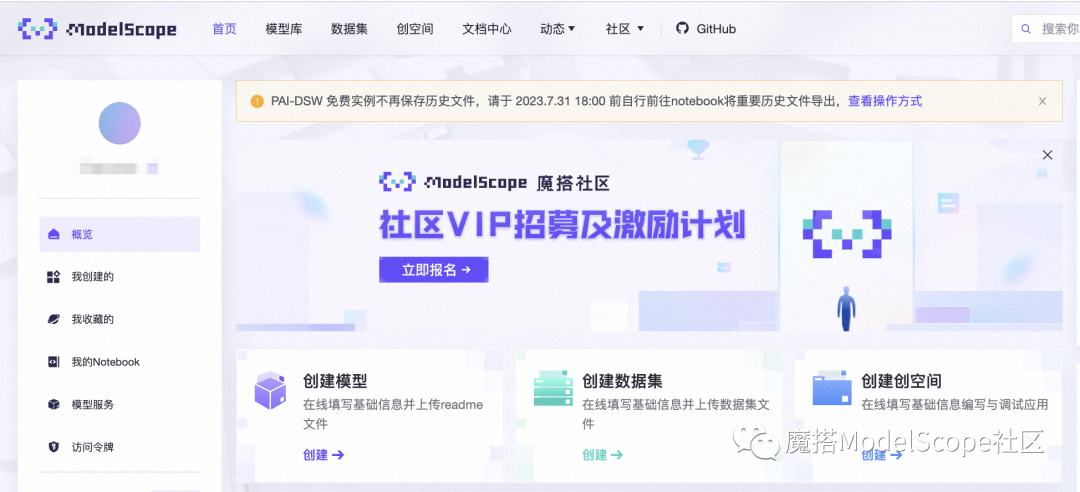
2、选择GPU环境,进入PAI-DSW在线开发环境
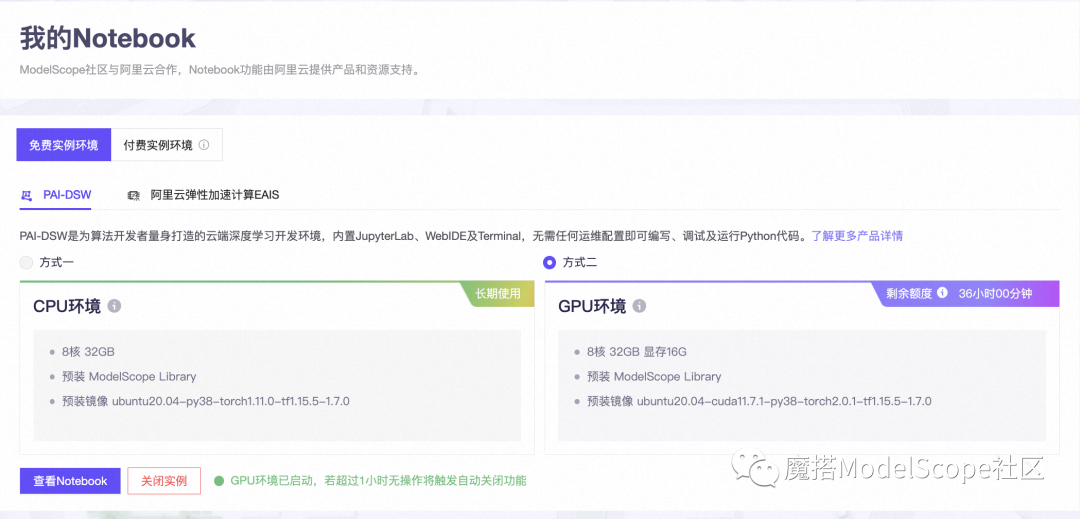
3、新建Notebook
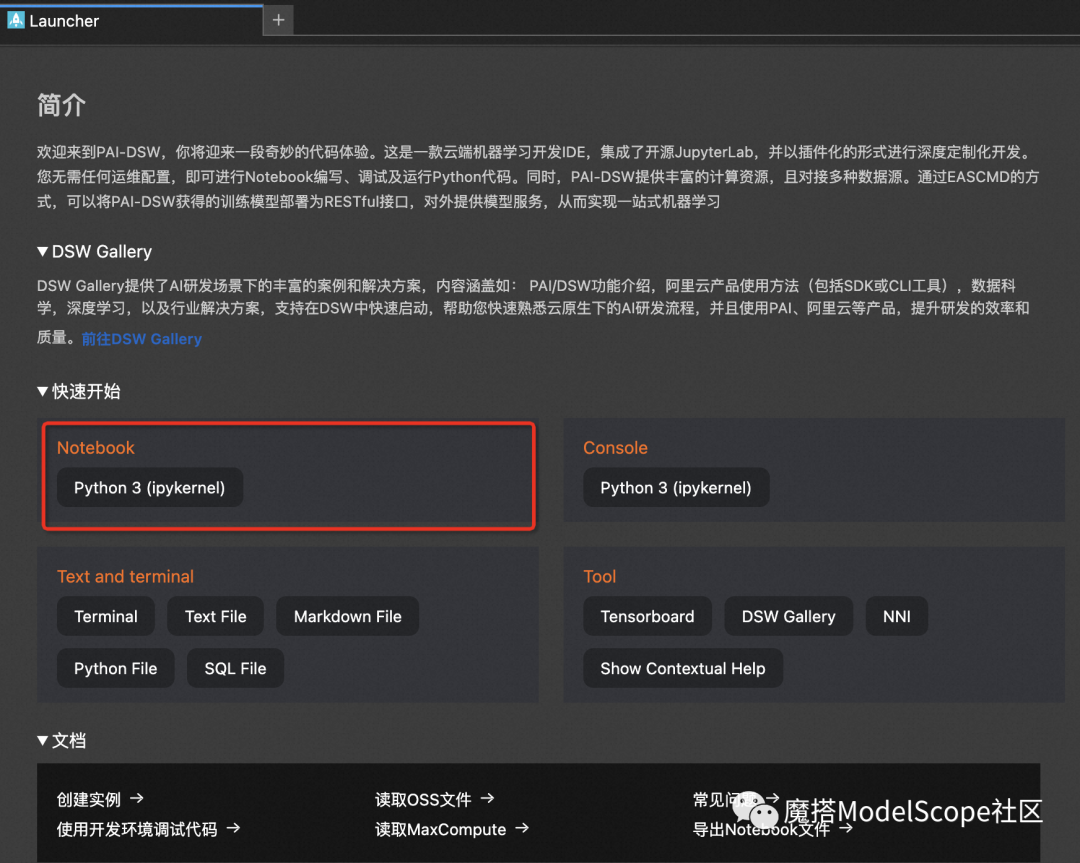
Qwen系列模型现已在ModelScope社区开源,包括:
Qwen-7B
模型链接:https://modelscope.cn/models/qwen/Qwen-7B/summary
Qwen-7B-Chat
模型链接:https://modelscope.cn/models/Qwen/Qwen-7b-chat/summary
社区支持直接下载模型的repo:
from modelscope.hub.snapshot_download import snapshot_download
model_dir = snapshot_download('Qwen/Qwen-7b-chat', 'v1.0.0')
或者通过如下代码,实现模型下载,以及load model, tokenizer:
def get_model_tokenizer_Qwen(model_dir: str,
torch_dtype: Dtype,
load_model: bool = True):
config = read_config(model_dir)
logger.info(config)
model_config = QwenConfig.from_pretrained(model_dir)
model_config.torch_dtype = torch_dtype
logger.info(model_config)
tokenizer = QwenTokenizer.from_pretrained(model_dir)
model = None
if load_model:
model = Model.from_pretrained(
model_dir,
cfg_dict=config,
config=model_config,
device_map='auto',
torch_dtype=torch_dtype)
return model, tokenizer
get_model_tokenizer_Qwen(model_dir, torch.bfloat16)
Qwen-7B-Chat Bot创空间链接:https://modelscope.cn/studios/qwen/Qwen-7B-Chat-Demo/summary
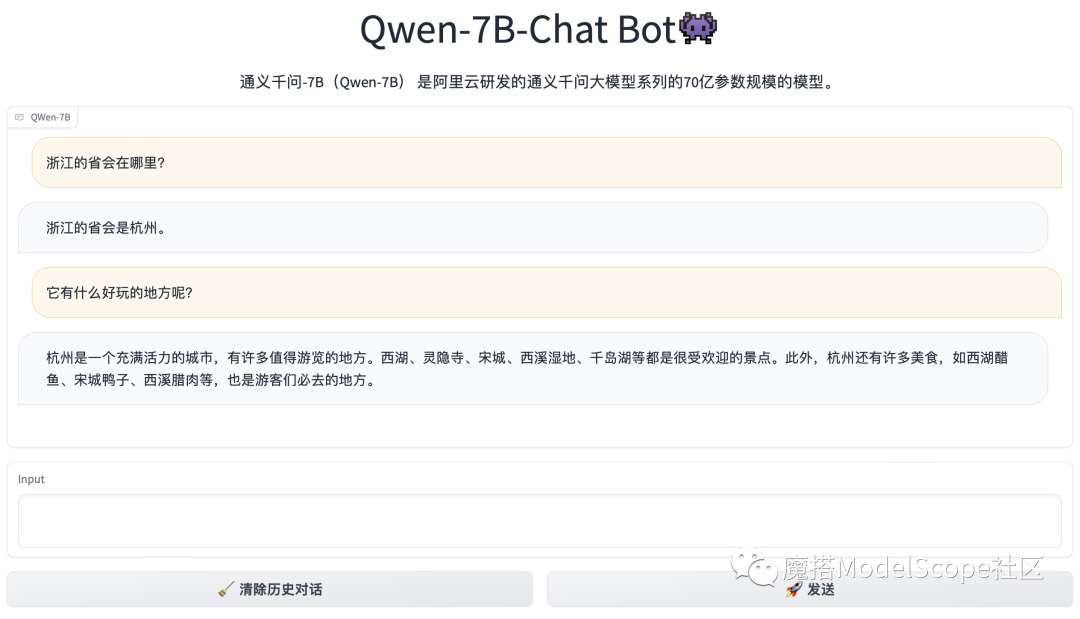
欢迎小伙伴们来创空间体验Qwen-7B-Chat的模型效果👏~
Qwen-7B-Chat推理代码:
import os
os.environ['CUDA_VISIBLE_DEVICES'] = '0'
from modelscope.pipelines import pipeline
from modelscope.utils.constant import Tasks
model_id = 'Qwen/Qwen-7b-chat'
pipe = pipeline(
task=Tasks.chat, model=model_id, device_map='auto')
history = None
system = 'You are a helpful assistant.'
text = '浙江的省会在哪里?'
results = pipe(text, history=history, system=system)
response, history = results['response'], results['history']
print(f'Response: {response}')
text = '它有什么好玩的地方呢?'
results = pipe(text, history=history, system=system)
response, history = results['response'], results['history']
print(f'Response: {response}')
"""
Response: 浙江的省会是杭州。
Response: 杭州是一座历史悠久、文化底蕴深厚的城市,拥有许多著名景点,如西湖、西溪湿地、
灵隐寺、千岛湖等,其中西湖是杭州最著名的景点,被誉为“天下第一湖”。此外,杭州还有许多古迹、
文化街区、美食和艺术空间等,值得一去。
"""
Qwen-7B推理代码:
import os
os.environ['CUDA_VISIBLE_DEVICES'] = '0'
from modelscope.pipelines import pipeline
from modelscope.utils.constant import Tasks
model_id = 'Qwen/Qwen-7b'
pipeline_ins = pipeline(
task=Tasks.text_generation, model=model_id, device_map='auto')
text = '蒙古国的首都是乌兰巴托(Ulaanbaatar)\n冰岛的首都是雷克雅未克(Reykjavik)\n埃塞俄比亚的首都是'
result = pipeline_ins(text)
print(result['text'])
这里使用魔搭上开源的数据集finance_en(包含68912条金融数据)作为微调数据集:
from modelscope import MsDataset
finance_en = MsDataset.load(
'wyj123456/finance_en', split='train').to_hf_dataset()
print(len(finance_en["instruction"]))
print(finance_en[0])
"""Out
68912
{'instruction': 'For a car, what scams can be plotted with 0
"""
微调Qwen-7B模型。这里基于ModelScope的开源轻量化微调工具swift来实现。
开源代码:https://github.com/modelscope/swift/blob/main/examples/pytorch/llm/llm_sft.py
git clone swift后,运行sft代码:
git clone https://github.com/modelscope/swift.git
cd swift/examples/pytorch/llm
bash run_sft.sh
# note: utils can be found ata
# `https://github.com/modelscope/swift/tree/main/examples/pytorch/llm/utils`
# it is recommended that you git clone the swift repo
import os
from dataclasses import dataclass, field
from functools import partial
from types import MethodType
from typing import List, Optional
import torch
from torch import Tensor
from utils import (DATASET_MAPPING, DEFAULT_PROMPT, MODEL_MAPPING,
get_dataset, get_model_tokenizer, plot_images,
process_dataset, select_dtype)
from swift import (HubStrategy, Seq2SeqTrainer,
Seq2SeqTrainingArguments,
get_logger)
from swift.utils import (add_version_to_work_dir, parse_args,
print_model_info, seed_everything,
show_freeze_layers)
from swift.utils.llm_utils import (data_collate_fn, print_example,
stat_dataset, tokenize_function)
logger = get_logger()
@dataclass
class SftArguments:
model_type: str = field(
default='Qwen-7b',
metadata={'choices': list(MODEL_MAPPING.keys())})
sft_type: str = field(
default='lora', metadata={'choices': ['lora', 'full']})
output_dir: Optional[str] = None
seed: int = 42
resume_from_ckpt: Optional[str] = None
dtype: Optional[str] = field(
default=None, metadata={'choices': {'bf16', 'fp16', 'fp32'}})
ignore_args_error: bool = False
dataset: str = field(
default='finance-en',
metadata={'help': f'dataset choices: {list(DATASET_MAPPING.keys())}'})
dataset_seed: int = 42
dataset_sample: Optional[int] = None
dataset_test_size: float = 0.01
prompt: str = DEFAULT_PROMPT
max_length: Optional[int] = 2048
lora_target_modules: Optional[List[str]] = None
lora_rank: int = 8
lora_alpha: int = 32
lora_dropout_p: float = 0.1
gradient_checkpoint: bool = True
batch_size: int = 1
num_train_epochs: int = 1
optim: str = 'adamw_torch'
learning_rate: Optional[float] = None
weight_decay: float = 0.01
gradient_accumulation_steps: int = 16
max_grad_norm: float = 1.
lr_scheduler_type: str = 'cosine'
warmup_ratio: float = 0.1
eval_steps: int = 50
save_steps: Optional[int] = None
save_total_limit: int = 2
logging_steps: int = 5
push_to_hub: bool = False
hub_model_id: Optional[str] = None
hub_private_repo: bool = True
hub_strategy: HubStrategy = HubStrategy.EVERY_SAVE
hub_token: Optional[str] = None
def __post_init__(self):
if self.sft_type == 'lora':
if self.learning_rate is None:
self.learning_rate = 1e-4
if self.save_steps is None:
self.save_steps = self.eval_steps
elif self.sft_type == 'full':
if self.learning_rate is None:
self.learning_rate = 1e-5
if self.save_steps is None:
self.save_steps = self.eval_steps * 4
else:
raise ValueError(f'sft_type: {self.sft_type}')
if self.output_dir is None:
self.output_dir = 'runs'
self.output_dir = os.path.join(self.output_dir, self.model_type)
if self.lora_target_modules is None:
self.lora_target_modules = MODEL_MAPPING[
self.model_type]['lora_TM']
self.torch_dtype, self.fp16, self.bf16 = select_dtype(
self.dtype, self.model_type)
if self.hub_model_id is None:
self.hub_model_id = f'{self.model_type}-sft'
seed_everything(args.seed)
# ### Load Model and Tokenizer
model, tokenizer = get_model_tokenizer(args.model_type, torch_dtype=args.torch_dtype)
if args.gradient_checkpoint:
model.gradient_checkpointing_enable()
model.enable_input_require_grads()
if args.sft_type == 'lora':
from swift import LoRAConfig, Swift
if args.resume_from_ckpt is None:
lora_config = LoRAConfig(
r=args.lora_rank,
target_modules=args.lora_target_modules,
lora_alpha=args.lora_alpha,
lora_dropout=args.lora_dropout_p)
logger.info(f'lora_config: {lora_config}')
model = Swift.prepare_model(model, lora_config)
else:
model = Swift.from_pretrained(
model, args.resume_from_ckpt, is_trainable=True)
show_freeze_layers(model)
print_model_info(model)
_p: Tensor = list(model.parameters())[-1]
logger.info(f'device: {_p.device}, dtype: {_p.dtype}')
# ### Load Dataset
dataset = get_dataset(args.dataset.split(','))
train_dataset, val_dataset = process_dataset(dataset,
args.dataset_test_size,
args.dataset_sample,
args.dataset_seed)
tokenize_func = partial(
tokenize_function,
tokenizer=tokenizer,
prompt=args.prompt,
max_length=args.max_length)
train_dataset = train_dataset.map(tokenize_func)
val_dataset = val_dataset.map(tokenize_func)
del dataset
# Data analysis
stat_dataset(train_dataset)
stat_dataset(val_dataset)
data_collator = partial(data_collate_fn, tokenizer=tokenizer)
print_example(train_dataset[0], tokenizer)
output_dir = add_version_to_work_dir(args.output_dir)
trainer_args = Seq2SeqTrainingArguments(
output_dir=output_dir,
do_train=True,
do_eval=True,
evaluation_strategy='steps',
per_device_train_batch_size=args.batch_size,
per_device_eval_batch_size=args.batch_size,
gradient_accumulation_steps=args.gradient_accumulation_steps,
learning_rate=args.learning_rate,
weight_decay=args.weight_decay,
max_grad_norm=args.max_grad_norm,
num_train_epochs=args.num_train_epochs,
lr_scheduler_type=args.lr_scheduler_type,
warmup_ratio=args.warmup_ratio,
logging_steps=args.logging_steps,
save_strategy='steps',
save_steps=args.save_steps,
save_total_limit=args.save_total_limit,
bf16=args.bf16,
fp16=args.fp16,
eval_steps=args.eval_steps,
dataloader_num_workers=1,
load_best_model_at_end=True,
metric_for_best_model='loss',
greater_is_better=False,
sortish_sampler=True,
optim=args.optim,
hub_model_id=args.hub_model_id,
hub_private_repo=args.hub_private_repo,
hub_strategy=args.hub_strategy,
hub_token=args.hub_token,
push_to_hub=args.push_to_hub,
resume_from_checkpoint=args.resume_from_ckpt)
trainer = Seq2SeqTrainer(
model=model,
args=trainer_args,
data_collator=data_collator,
train_dataset=train_dataset,
eval_dataset=val_dataset,
tokenizer=tokenizer,
)
trainer.train()
Tensorboard 命令: (e.g.)
tensorboard --logdir runs/Qwen-7b/v0-20230802-170622/runs --port 6006
# ### Visualization
images_dir = os.path.join(output_dir, 'images')
tb_dir = os.path.join(output_dir, 'runs')
folder_name = os.listdir(tb_dir)[0]
tb_dir = os.path.join(tb_dir, folder_name)
plot_images(images_dir, tb_dir, ['train/loss'], 0.9)
if args.push_to_hub:
trainer._add_patterns_to_gitignores(['images/'])
trainer.push_to_hub()
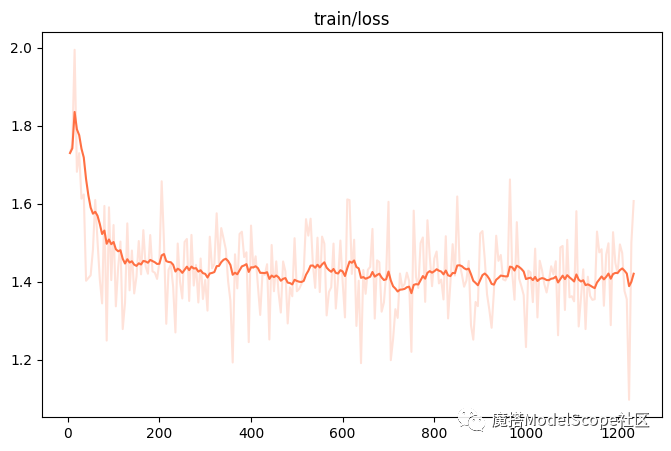
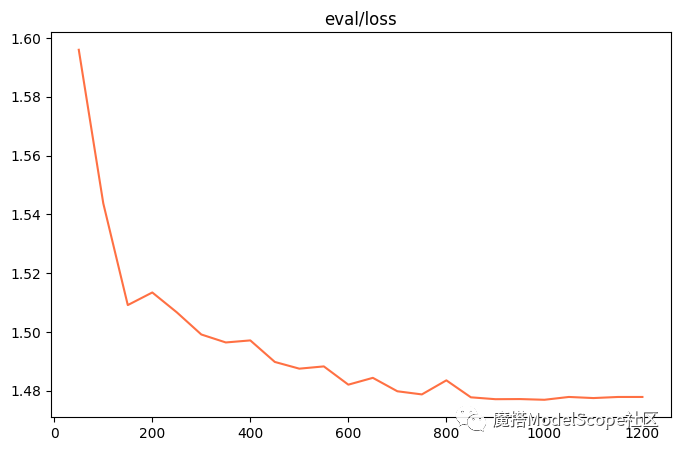
Qwen-7B用lora的方式微调的显存占用如下,大约在21G. (batch_size=1, max_length=2048)

代码链接:https://github.com/modelscope/swift/blob/main/examples/pytorch/llm/llm_infer.py
bash run_infer.sh
import os
from dataclasses import dataclass, field
from functools import partial
from typing import List, Optional
import torch
from transformers import GenerationConfig, TextStreamer
from utils import (DATASET_MAPPER, DEFAULT_PROMPT, MODEL_MAPPER, get_dataset,
get_model_tokenizer, inference, parse_args, process_dataset,
tokenize_function)
from modelscope import get_logger
from modelscope.swift import LoRAConfig, Swift
logger = get_logger()
@dataclass
class InferArguments:
model_type: str = field(
default='Qwen-7b', metadata={'choices': list(MODEL_MAPPER.keys())})
sft_type: str = field(
default='lora', metadata={'choices': ['lora', 'full']})
ckpt_path: str = '/path/to/your/iter_xxx.pth'
eval_human: bool = False
ignore_args_error: bool = False
dataset: str = field(
default='finance_en',
metadata={'help': f'dataset choices: {list(DATASET_MAPPER.keys())}'})
dataset_seed: int = 42
dataset_sample: Optional[int] = None
dataset_test_size: float = 0.01
prompt: str = DEFAULT_PROMPT
max_length: Optional[int] = 2048
lora_target_modules: Optional[List[str]] = None
lora_rank: int = 8
lora_alpha: int = 32
lora_dropout_p: float = 0.1
max_new_tokens: int = 512
temperature: float = 0.9
top_k: int = 50
top_p: float = 0.9
def __post_init__(self):
if self.lora_target_modules is None:
self.lora_target_modules = MODEL_MAPPER[self.model_type]['lora_TM']
if not os.path.isfile(self.ckpt_path):
raise ValueError(
f'Please enter a valid ckpt_path: {self.ckpt_path}')
def llm_infer(args: InferArguments) -> None:
support_bf16 = torch.cuda.is_bf16_supported()
if not support_bf16:
logger.warning(f'support_bf16: {support_bf16}')
model, tokenizer, _ = get_model_tokenizer(
args.model_type, torch_dtype=torch.bfloat16)
if args.sft_type == 'lora':
lora_config = LoRAConfig(
replace_modules=args.lora_target_modules,
rank=args.lora_rank,
lora_alpha=args.lora_alpha,
lora_dropout=args.lora_dropout_p,
pretrained_weights=args.ckpt_path)
logger.info(f'lora_config: {lora_config}')
model = Swift.prepare_model(model, lora_config)
elif args.sft_type == 'full':
state_dict = torch.load(args.ckpt_path, map_location='cpu')
model.load_state_dict(state_dict)
else:
raise ValueError(f'args.sft_type: {args.sft_type}')
tokenize_func = partial(
tokenize_function,
tokenizer=tokenizer,
prompt=args.prompt,
max_length=args.max_length)
streamer = TextStreamer(
tokenizer, skip_prompt=True, skip_special_tokens=True)
generation_config = GenerationConfig(
max_new_tokens=args.max_new_tokens,
temperature=args.temperature,
top_k=args.top_k,
top_p=args.top_p,
do_sample=True,
pad_token_id=tokenizer.eos_token_id)
logger.info(f'generation_config: {generation_config}')
if args.eval_human:
while True:
instruction = input('<<< ')
data = {'instruction': instruction}
input_ids = tokenize_func(data)['input_ids']
inference(input_ids, model, tokenizer, streamer, generation_config)
print('-' * 80)
else:
dataset = get_dataset(args.dataset.split(','))
_, test_dataset = process_dataset(dataset, args.dataset_test_size,
args.dataset_sample,
args.dataset_seed)
mini_test_dataset = test_dataset.select(range(10))
del dataset
for data in mini_test_dataset:
output = data['output']
data['output'] = None
input_ids = tokenize_func(data)['input_ids']
inference(input_ids, model, tokenizer, streamer, generation_config)
print()
print(f'[LABELS]{output}')
print('-' * 80)
if __name__ == '__main__':
args, remaining_argv = parse_args(InferArguments)
if len(remaining_argv) > 0:
if args.ignore_args_error:
logger.warning(f'remaining_argv: {remaining_argv}')
else:
raise ValueError(f'remaining_argv: {remaining_argv}')
llm_infer(args)
模型体验链接:https://modelscope.cn/studios/qwen/Qwen-7B-Chat-Demo/summary